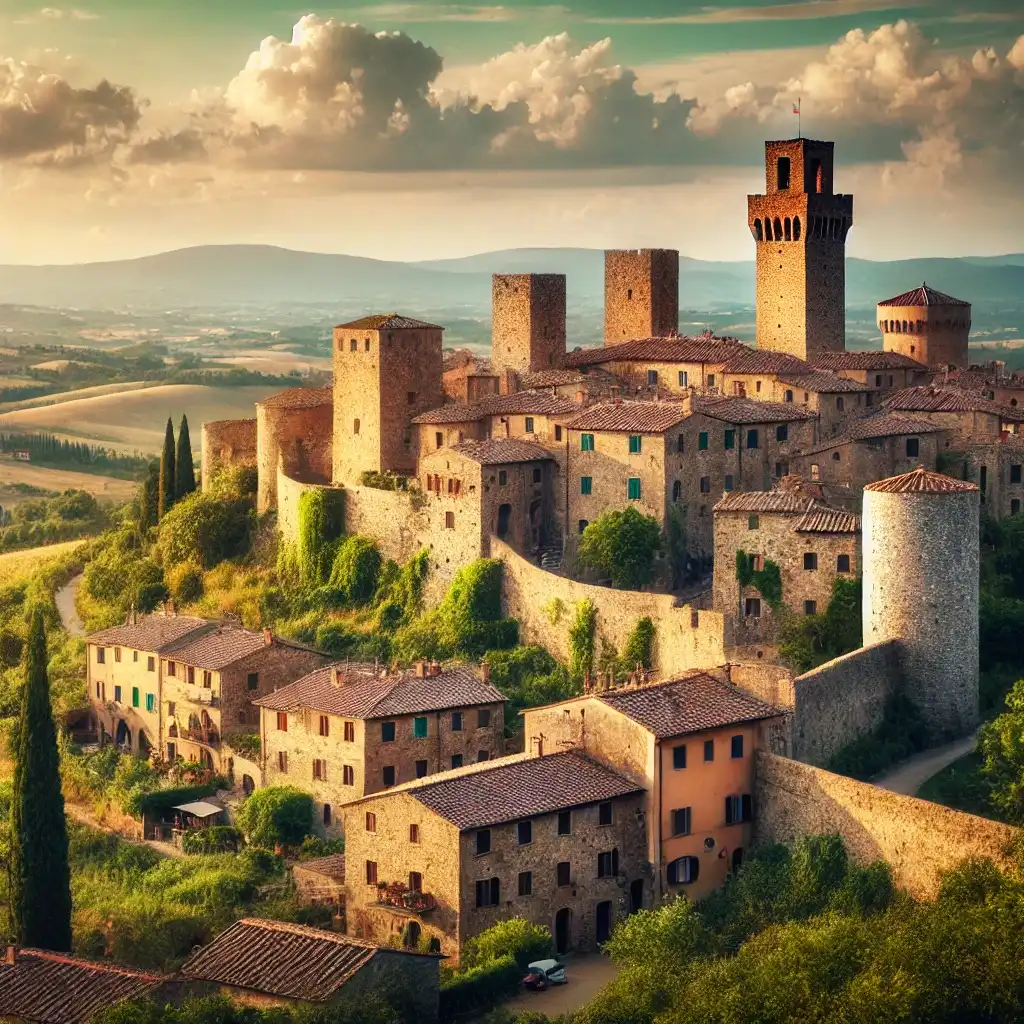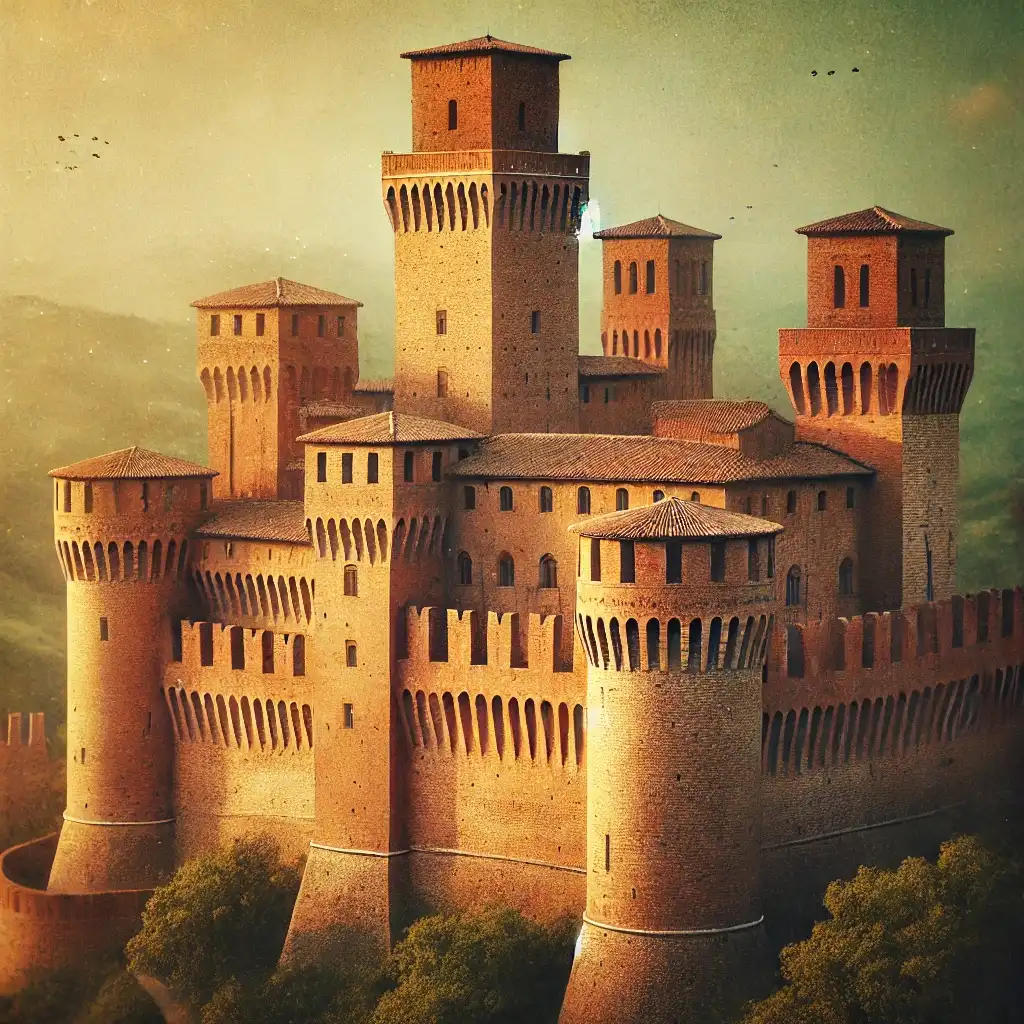
Traveling through Italy’s medieval villages means immersing yourself in a past of fortified walls, ancient castles, and stone streets that tell tales of knights, counts, and merchants. In these corners of Italy, time seems to stand still, and traditions resonate in the architecture and stories passed down. This itinerary takes us to ten medieval villages, each with unique characteristics: fortified villages, perched on hills or built around magnificent abbeys.
Fortified Villages: Witnesses of a History of Battles
- Monteriggioni (Tuscany)
- Known for its imposing walls and 14 intact towers, Monteriggioni is a medieval village built in the 13th century to protect Siena from Florentine incursions. Walking along the walls, one breathes the ancient spirit of defense while enjoying a spectacular view of the Tuscan countryside.
- Gradara (Marche)
- Perched on a hill, the village of Gradara is famous for the Gradara Castle, the setting of the tragic love story between Paolo and Francesca, as recounted by Dante in the Divine Comedy. Its perfectly preserved defensive walls make it one of Italy’s most picturesque fortified villages.
Villages with Castles: Noble and Knightly Residences
- Castell’Arquato (Emilia-Romagna)
- This fairy-tale-like village is dominated by the Visconti Fortress and has a history of alliances and rivalries among noble families. The fortress offers a breathtaking panoramic view of the Val d’Arda, showcasing the grandeur of medieval residences.
- Verrucchio (Emilia-Romagna)
- Known for its impressive castle, Verrucchio is tied to the Malatesta, one of medieval Italy’s most powerful families. The Malatesta Fortress stands proudly and houses ancient artifacts that tell the story of the area.
Religious Villages: Sanctuaries of Peace and Spirituality
- Subiaco (Lazio)
- Steeped in spirituality, Subiaco is home to the Benedictine monasteries of Santa Scolastica and San Benedetto, the latter built around the cave where Saint Benedict spent three years in meditation. The peaceful, silent atmosphere is ideal for those seeking an introspective experience.
- Norcia (Umbria)
- The birthplace of Saint Benedict, Norcia is a spiritual and cultural center filled with churches and abbeys. The Abbey of Saint Benedict is the spiritual heart of the town, and a walk through the village streets offers insights into local craftsmanship and culinary traditions.
Villages of Nature and Architecture: Where Landscape Is Integral
- Pitigliano (Tuscany)
- Known as ‘Little Jerusalem’ due to its historic Jewish community, Pitigliano sits on a tuff cliff and offers unique views. The village’s houses blend seamlessly with the rock, creating a breathtaking landscape that reflects the harmony between people and nature.
- Civita di Bagnoregio (Lazio)
- Known as “the dying town” due to the constant erosion of its foundation, Civita di Bagnoregio is a natural and architectural wonder. The village is accessible only on foot, via a suspended bridge, offering stunning views over the surrounding valleys.

Craft Villages: Where Artisan Traditions Are Still Alive
- Orvieto (Umbria)
- Beyond its famous cathedral, Orvieto is renowned for its ceramic tradition dating back to Etruscan times. The village streets are filled with artisan shops, where visitors can watch local artists create unique, authentic pieces.
- Suvereto (Tuscany)
- This wine-producing village in the Val di Cornia combines medieval charm with a deep-rooted wine culture. Each summer, medieval festivals and local wine tastings provide visitors with a sensory experience that unites history and flavor.
Conclusion
Italy’s medieval villages are treasure troves of history and beauty waiting to be explored. Amid ancient walls, castles, and monasteries, each village is a small world where past and present merge, offering visitors a unique, unforgettable experience. If you’re looking for an authentic Italian experience, these villages are an excellent choice: a journey through time, discovering our roots.
FAQ
- What is the best time to visit Italy’s medieval villages?
- The best times are generally spring (April-May) and fall (September-October) when the weather is mild and there are fewer tourists.
- How can I reach the more isolated villages?
- Some villages are well-connected by bus or train, while for others, renting a car is recommended to easily reach even the less accessible areas.
- Which villages are best for visiting with children?
- Villages like Castell’Arquato or Monteriggioni offer attractions suitable for children, such as castles and simple, engaging historical paths.


